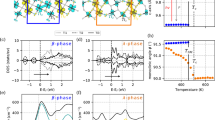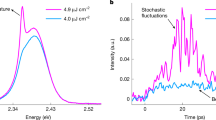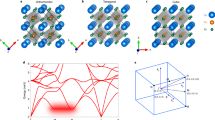Abstract
The development of X-ray and electron diffraction methods with ultrahigh time resolution has made it possible to map directly, at the atomic level, structural changes in solids induced by laser excitation1,2,3,4,5,6,7,8. This has resulted in unprecedented insights into the lattice dynamics of solids undergoing phase transitions. In aluminium, for example, femtosecond optical excitation hardly affects the potential energy surface of the lattice; instead, melting of the material is governed by the transfer of thermal energy between the excited electrons and the initially cold lattice1. In semiconductors, in contrast, exciting ∼10 per cent of the valence electrons results in non-thermal lattice collapse owing to the antibonding character of the conduction band2,3,4,5,9,10. These different material responses raise the intriguing question of how Peierls-distorted systems11 such as bismuth12 will respond to strong excitations. The evolution of the atomic configuration of bismuth upon excitation of its A1g lattice mode, which involves damped oscillations of atoms along the direction of the Peierls distortion of the crystal, has been probed6,7,8, but the actual melting of the material has not yet been investigated. Here we present a femtosecond electron diffraction study of the structural changes in crystalline bismuth as it undergoes laser-induced melting. We find that the dynamics of the phase transition depend strongly on the excitation intensity, with melting occurring within 190 fs (that is, within half a period of the unperturbed A1g lattice mode6,7,8) at the highest excitation. We attribute the surprising speed of the melting process to laser-induced changes in the potential energy surface of the lattice, which result in strong acceleration of the atoms along the longitudinal direction of the lattice and efficient coupling of this motion to an unstable transverse vibrational mode. That is, the atomic motions in crystalline bismuth can be electronically accelerated so that the solid-to-liquid13 phase transition occurs on a sub-vibrational timescale.
This is a preview of subscription content, access via your institution
Access options
Subscribe to this journal
Receive 51 print issues and online access
$199.00 per year
only $3.90 per issue
Buy this article
- Purchase on SpringerLink
- Instant access to full article PDF
Prices may be subject to local taxes which are calculated during checkout




Similar content being viewed by others
References
Siwick, B. J., Dwyer, J. R., Jordan, R. E. & Miller, R. J. D. An atomic-level view of melting using femtosecond electron diffraction. Science 302, 1382–1385 (2003)
Harb, M. et al. Electronically driven structure changes of Si captured by femtosecond electron diffraction. Phys. Rev. Lett. 100, 155504 (2008)
Siders, C. W. et al. Detection of nonthermal melting by ultrafast X-ray diffraction. Science 286, 1340–1342 (1999)
Lindenberg, A. M. et al. Atomic-scale visualization of inertial dynamics. Science 308, 392–395 (2005)
Hillyard, P. B. et al. Carrier-density-dependent lattice stability in InSb. Phys. Rev. Lett. 98, 125501 (2007)
Sokolowski-Tinten, K. et al. Femtosecond X-ray measurement of coherent lattice vibrations near the Lindemann stability limit. Nature 422, 287–289 (2003)
Fritz, D. M. et al. Ultrafast bond softening in bismuth: Mapping a solid’s interatomic potential with X-rays. Science 315, 633–636 (2007)
Johnson, S. L. et al. Nanoscale depth-resolved coherent femtosecond motion in laser-excited bismuth. Phys. Rev. Lett. 100, 155501 (2008)
Stampfli, P. & Bennemann, K. H. Theory for laser-induced femtosecond phase transition of silicon and GaAs. Appl. Phys. A 60, 191–196 (1995)
Zijlstra, E. S., Tatarinova, L. L. & Garcia, M. E. Anharmonic noninertial lattice dynamics during ultrafast nonthermal melting of InSb. Phys. Rev. Lett. 101, 135701 (2008)
Peierls, R. E. More Surprises in Theoretical Physics 24–26 (Princeton Univ. Press, 1991)
Madelung, O., Rössler, U. & Schulz, M. in Semiconductors Vol. 41C, Non-Tetrahedrally Bonded Elements and Binary Compounds I 1–3 (Springer, 1990)
Sharrah, P. C., Petz, J. I. & Kruh, R. F. Determination of atomic distributions in liquid lead-bismuth alloys by neutron and X-ray diffraction. J. Chem. Phys. 32, 241–246 (1960)
Gao, H. X. & Peng, L.-M. Parameterization of the temperature dependence of the Debye-Waller factors. Acta Crystallogr. A 55, 926–932 (1999)
Lide, D. R. (ed.) CRC Handbook of Chemistry and Physics 88th edn, Sec. 4, 127, 133, Sec. 6, 110 (CRC, 2007)
Murray, É. D., Fritz, D. M., Wahlstrand, J. K., Fahy, S. & Reis, D. A. Effect of lattice anharmonicity on high-amplitude phonon dynamics in photoexcited bismuth. Phys. Rev. B 72, 060301(R) (2005)
Zeiger, H. J. et al. Theory for displacive excitation of coherent phonons. Phys. Rev. B 45, 768–778 (1992)
Zijlstra, E. S., Tatarinova, L. L. & Garcia, M. E. Laser-induced phonon-phonon interactions in bismuth. Phys. Rev. B 74, 220301(R) (2006)
Zijlstra, E. S., Tatarinova, L. L. & Garcia, M. E. Ab-initio study of coherent phonons excited by femtosecond laser pulses in Bismuth. Proc. SPIE 6261, 62610R (2006)
Wu, X. & Xu, X. Coherent phonon excitation in bismuth. Appl. Surf. Sci. 253, 6301–6304 (2007)
Hebeisen, C. T. et al. Grating enhanced ponderomotive scattering for visualization and full characterization of femtosecond electron pulses. Opt. Express 16, 3334–3341 (2008)
Kammler, M. & Horn-von Hoegen, M. Low energy electron diffraction of epitaxial growth of bismuth on Si(111). Surf. Sci. 576, 56–60 (2005)
Payer et al. Ultrathin epitaxially grown bismuth (111) membranes. Appl. Phys. Lett. 93, 093102 (2008)
Acknowledgements
We thank A.-A. Dhirani for the use of his deposition chamber. We acknowledge financial support provided by the Natural Science and Engineering Research Council and the Deutsche Forschungsgemeinschaft within the SFB 616, Energy Dissipation at Surfaces. R.E. thanks the Alexander-von-Humboldt foundation for financial support.
Author information
Authors and Affiliations
Corresponding author
Rights and permissions
About this article
Cite this article
Sciaini, G., Harb, M., Kruglik, S. et al. Electronic acceleration of atomic motions and disordering in bismuth. Nature 458, 56–59 (2009). https://doi.org/10.1038/nature07788
Received:
Accepted:
Issue Date:
DOI: https://doi.org/10.1038/nature07788
This article is cited by
-
Ultrafast lattice disordering can be accelerated by electronic collisional forces
Nature Physics (2023)
-
Neural network interatomic potential for laser-excited materials
Communications Materials (2023)
-
Formation of Co–O bonds and reversal of thermal annealing effects induced by X-ray irradiation in (Y, Co)-codoped CeO2 nanocrystals
Scientific Reports (2022)
-
Direct observation of phonon squeezing in bismuth by mega-electron-volt ultrafast electron diffraction
Journal of the Korean Physical Society (2022)
-
The critical role of hot carrier cooling in optically excited structural transitions
npj Computational Materials (2021)



